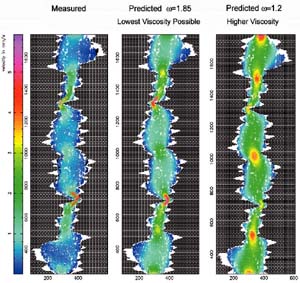| 2004 |

|
YEAR BOOK |
University of Ulster
|
Imaging fluid flow in complex media
|
Understanding fluid flow in the Earth's crust is important for a number of geophysical and environmental problems, including groundwater contamination, waste disposal, and oil extraction. Rocks in the crust are extremely heterogeneous, however, with fractal distributions of fractures and varying porosities, and hence correctly predicting fluid flow can be very difficult. The general approach to this problem is to construct sophisticated numerical models of the expected crustal heterogeneity and simulate flow within them. Unfortunately such models are only tested against simple geometries and therefore a leap of faith is required to assume that they actually produce the correct results in realistic complex geometries.

A comparison between observed and simulated velocity fields is shown in the figure. Here the model was a single rough fracture, but similar comparisons have been made in fractured porous media. The fracture on the left shows the measured velocity field, while the two on the right are for Modified Lattice Boltzman simulations in a fracture with the same geometry. There are clear differences between the measured and simulated velocity fields, which appear to be due to problems in defining viscosity accurately in the numerical model.
The velocity fields measured during this project are available from the Geophysics Research Group.
More information about the Group and its work on fluid flow in fractured porous media, earthquake physics, and aeolian sediment transport can be found at
http://www.science.ulst.ac.uk/crg/geophys/index.html
or by emailing Prof. John McCloskey at [email protected]